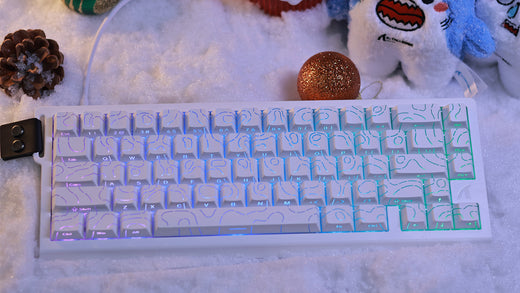Un clavier 60 % révolutionne les expériences de frappe traditionnelles en réduisant considérablement la taille du clavier tout en maintenant la fonctionnalité de base. Les claviers mécaniques compacts suppriment les touches inutiles, créant un design minimaliste qui attire les utilisateurs cherchant l'efficacité et l'optimisation de l'espace de travail. En ne conservant que les touches essentielles, les claviers 60 % offrent une solution rationalisée pour les professionnels, les joueurs et quiconque cherchant à désencombrer son bureau et à améliorer son installation de frappe avec un design de clavier plus ciblé et intentionnel.
Qu'est-ce qui caractérise un clavier 60 % ?
Un clavier 60 % contient généralement 61 touches, représentant environ 60 % de la disposition d'un clavier de taille standard. Son design compact supprime stratégiquement le pavé numérique, la rangée de fonction et les touches de navigation dédiées tout en préservant les touches alphanumériques et les touches de modification critiques.
Comparé aux claviers de taille normale, qui présentent souvent 104 touches, et aux modèles tenkeyless qui éliminent simplement le pavé numérique, les claviers 60 % vont encore plus loin dans la réduction de l'espace occupé par le clavier. Les éléments de base de la frappe—lettres, chiffres, touches principales de modification et barre d'espace—sont inclus dans la disposition.
Les omissions notables sont les touches de fonction, les pavés numériques et les touches fléchées dédiées. Généralement accessibles via des couches de fonction créatives, ces composants manquants permettent aux utilisateurs de conserver l'intégralité des capacités du clavier dans un espace beaucoup plus petit.

Quelles sont les caractéristiques principales des claviers 60 % ?
La caractéristique définissante des claviers 60 % est leur design compact ingénieux, qui ne compromet pas la fonctionnalité. Les couches de fonction deviennent le principal moyen d'accéder à des fonctions supplémentaires des touches, permettant aux utilisateurs d'effectuer des opérations complexes grâce à des combinaisons de touches stratégiques.
La personnalisation est au cœur de l'attrait des claviers 60 %. Les passionnés d'interrupteurs mécaniques peuvent facilement échanger des interrupteurs, expérimenter avec des ensembles de keycaps uniques et programmer des mappages de touches complexes. Cette flexibilité transforme le clavier d'un simple dispositif d'entrée en un outil personnalisé.
Un autre avantage important est l'architecture gain de place. Ces claviers génèrent suffisamment d'espace sur le bureau pour permettre un mouvement de souris plus confortable et un environnement de travail plus propre. Les professionnels travaillant dans de petits espaces, les programmeurs et les joueurs apprécient particulièrement cette capacité.
Améliorant encore l'adaptabilité du clavier 60 % se trouvent des connectivités sans fil et des choix d'éclairage RGB, qui attirent les consommateurs recherchant à la fois utilité et valeur esthétique.

Qui utilise des claviers 60 % ?
Différents professionnels trouvent une valeur unique dans les claviers 60 % à travers divers domaines.
- Les joueurs apprécient l'espace supplémentaire pour le mouvement de la souris, surtout dans les jeux de tir à la première personne où le contrôle précis du curseur est crucial. Un positionnement de souris plus agressif et des réactions plus rapides rendus possibles par le clavier plus petit permettent
- Les programmeurs construisent des environnements de codage propres et ordonnés avec des designs compacts. Les couches personnalisables permettent une navigation rapide et une exécution complète avec peu de mouvements de main en soutenant des processus sophistiqués.
- Les écrivains bénéficient d'avantages ergonomiques, augmentant potentiellement la vitesse de frappe et réduisant la fatigue des mains. La distance réduite entre les touches peut mener à des schémas de frappe plus efficaces et moins de fatigue des mains lors de longues sessions d'écriture.
- Les professionnels créatifs et les amateurs de minimalisme apprécient l'esthétique élégante et la complexité visuelle réduite.
- Les freelances et les nomades numériques trouvent la portabilité particulièrement attrayante, transportant facilement un clavier léger et compact entre les espaces de travail.

Quels sont les avantages et les inconvénients des claviers 60 % ?
Les claviers 60 % offrent des avantages remarquables, notamment une efficacité d'espace exceptionnelle et une portabilité améliorée. Le design compact réduit l'encombrement du bureau et offre plus d'espace pour le mouvement de la souris, créant un espace de travail plus flexible.
Les options de personnalisation permettent aux utilisateurs de créer une expérience de frappe véritablement personnalisée. La variété des interrupteurs mécaniques, les couches programmables et les keycaps interchangeables offrent une flexibilité sans précédent.
Cependant, il existe certaines restrictions possibles. Pour les utilisateurs de claviers de taille normale, la courbe d'apprentissage peut être élevée. Les tâches spécifiques nécessitant une saisie fréquente de chiffres ou plusieurs touches de fonction peuvent devenir plus difficiles.
Tout le monde ne trouvera pas la petite disposition agréable. Les personnes ayant de plus grandes mains ou des besoins de flux de travail spécifiques pourraient trouver le design réduit difficile. L'absence de touches de navigation spécifiques nécessite de la flexibilité et l'apprentissage d'autres combinaisons de touches.
Les professionnels doivent soigneusement considérer leurs besoins spécifiques, leurs habitudes de frappe et les contraintes de leur espace de travail avant de s'engager dans un clavier 60 %.
Comment utiliser un clavier 60 %
Maîtriser un clavier 60 % nécessite de comprendre les couches de fonction et les combinaisons de touches. Les touches manquantes comme les flèches sont généralement accessibles en maintenant la touche Fn tout en appuyant sur des touches alternatives désignées. De nombreux claviers utilisent les touches WASD ou IJKL comme remplacements des touches fléchées dans les couches de fonction.
Les changements de firmware offrent d'excellentes opportunités de personnalisation. Les utilisateurs peuvent créer des mappages de touches complexes, des macros logicielles et des mises en page personnalisées qui améliorent l'efficacité. Apprendre ces raccourcis transforme la première difficulté en une expérience de frappe assez efficace.
S'adapter au petit espace dépend principalement de la pratique. Les utilisateurs devraient passer du temps à apprendre le design particulier de la couche de fonction de leur clavier et à explorer les choix de personnalisation. Pour apprendre la fonctionnalité du clavier 60 %, des cours en ligne, des directives des fabricants et des groupes d'enthousiastes de claviers offrent des outils précieux.
Expérimenter différentes combinaisons de touches et documenter des raccourcis personnels peut considérablement améliorer l'efficacité et le confort de frappe globaux.
Comment choisir le bon clavier 60 %
Choisir un clavier 60 % nécessite une évaluation approfondie de plusieurs critères. Les types d'interrupteurs sont très importants ; les interrupteurs mécaniques offrent différentes expériences de frappe. Alors que certains utilisateurs préfèrent des alternatives plus douces et silencieuses, d'autres trouvent les interrupteurs clicky pour un retour tactile préférables.
Les facteurs d'évaluation essentiels incluent la compatibilité avec les appareils principaux, les choix de connectivité sans fil et la qualité de construction. Les interrupteurs hot-swappable et l'illumination RGB aident à améliorer l'adaptabilité du clavier et offrent davantage d'options de personnalisation.
Les préoccupations budgétaires sont très importantes ; les prix varient des produits d'entrée de gamme abordables aux claviers personnalisés haut de gamme. Les acheteurs potentiels devraient évaluer leurs besoins particuliers à la lumière d'éléments tels que le cas d'utilisation principal, la fréquence de frappe et le degré de personnalisation souhaité.
Prendre une décision sera éclairé par la connaissance des préférences de frappe personnelles, l'exploration des évaluations des utilisateurs et, lorsque cela est possible, l'essai personnel des claviers.
Devriez-vous choisir un clavier 60 % ?
Un clavier 60 % est une réponse astucieuse pour l'optimisation des espaces de travail modernes. Pour ceux qui recherchent l'efficacité, la mobilité et la personnalisation, ces claviers offrent des avantages convaincants même s'ils ne sont pas idéaux partout.
Ce design de clavier créatif sera très apprécié par les professionnels, les joueurs et les amateurs de minimalisme. Le succès dépend de la volonté individuelle de changer, de grandir et d'accepter un style de gestion de frappe et d'espace de travail plus simple.





Laisser un commentaire
Ce site est protégé par hCaptcha, et la Politique de confidentialité et les Conditions de service de hCaptcha s’appliquent.